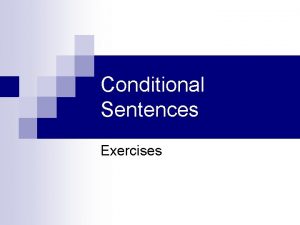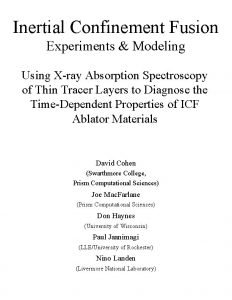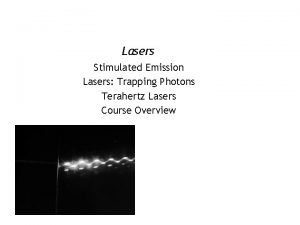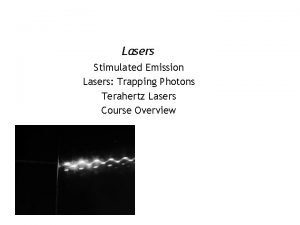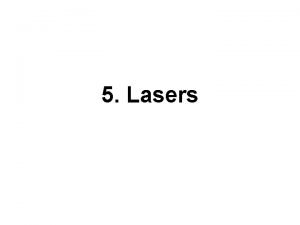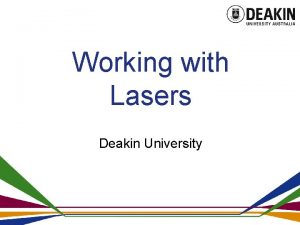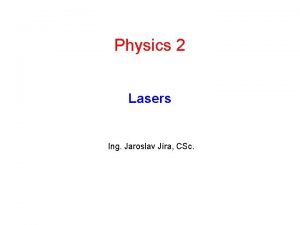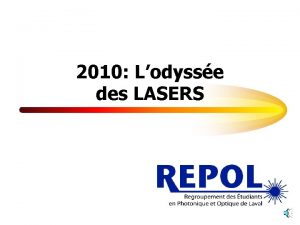LASERS Does anyone have lasers at home they























- Slides: 23

LASERS Does anyone have lasers at home they can share with me for a few days? We can use them for doing a lab on wave behaviors next week

Waves • How energy travels from one place to another • (you need energy to start it, and it doesn’t stop until all the energy is transferred)

What is a Wave? • A disturbance that carries energy through matter or space

Mechanical Waves • Mechanical Waves- must have matter to move through called a MEDIUM • Sound waves • Earthquake waves • What is a medium (any kind of matter disturbed by the energy of a wave)

What is a Wave? • What is the medium for waves at the beach?

What is a Wave? • What is the medium for waves coming out of your television?

What is a Wave? • What is the medium for waves in a football stadium?

What is a Wave? • What is the medium for waves that cause an earthquake?

Two Basic Types of Mechanical Waves Transverse and Longitudinal • 1. Transverse Waves • The disturbance runs perpendicular to the wave’s direction • Looks more like a wave at the beach

Transverse Waves • Move in an up and down motion perpendicular to the direction of the wave

Transverse Wave Anatomy Wavelength λ Crest/Peak Amplitude Resting Point Trough

Parts of a Transverse Wave • Crest: highest point of the wave • Trough: lowest point of the wave

Parts of a Transverse Wave cont’d Wavelength: ( ) Distance between a point on one wave to the identical point on the next wave (One whole Wave) Amplitude: (a) Distance from the crest or trough of a wave to the resting point

nd 2 Type of Mechanical Wave • Longitudinal Waves a. k. a. Compressional Waves – Sound Waves – Some Earthquake Waves

Longitudinal Wave • Matter vibrates in the direction of the wave • Energy moves parallel to the matter • Examples: Sound waves, springs, coils


How does a Longitudinal wave work? • Compressions expand to an area that is less dense • Rarefaction: The less dense area in a compressional wave

How Does a Longitudinal Wave Work? (Cont’d) • Wavelength ( ): One compression and one rarefraction

When Waves Hit Things Reflection: The wave bounces off the new medium and can change direction

Refraction: The wave enters a new medium and changes speed This is responsible for “weirdness” when you look at things through water – magnification, warping, etc…

Diffraction: The wave bends around corners or edges of a barrier

Frequency of a wave Frequency: the number of waves that pass a point in a given amount of time. Measured in Hertz (Hz)

Speed of Waves Wave speed is equal to the frequency of the wave times the wavelength. Vw = f λ (units: meters/second, or equivalent) Look at that formula – if Vw stays the same. What can you say about f and λ?
 If your conditions are competitive we (place)
If your conditions are competitive we (place) Properties of laser light
Properties of laser light Audience scanning
Audience scanning Inertial confinement fusion lasers
Inertial confinement fusion lasers Types of lasers
Types of lasers A storage device that uses lasers to read data
A storage device that uses lasers to read data Machine vision lasers
Machine vision lasers Audience scanning
Audience scanning Audience scanning lasers
Audience scanning lasers It has six faces, eight vertices and twelve edges
It has six faces, eight vertices and twelve edges Does congress have the power to have no mail on saturdays
Does congress have the power to have no mail on saturdays Pengertian home care
Pengertian home care Perbedaan home care dan home visit
Perbedaan home care dan home visit Mobile home exchange
Mobile home exchange Flower plural
Flower plural Come home come home jesus is calling
Come home come home jesus is calling Oak springs mobile home park
Oak springs mobile home park Let's go to my house let's go today
Let's go to my house let's go today Arman home sweet home
Arman home sweet home She said that, home economics stands for the ideal home.
She said that, home economics stands for the ideal home. Home sweet home survival
Home sweet home survival Spoken word poetry allows you to be anyone you want to be
Spoken word poetry allows you to be anyone you want to be Repetition sound device
Repetition sound device If anyone comes preaching another jesus
If anyone comes preaching another jesus
